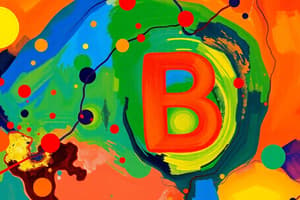Podcast
Questions and Answers
What is a key function of Vitamin A?
What is a key function of Vitamin A?
- Supports immune function
- Improves iron absorption
- Regulates cholesterol levels
- Aids in night vision (correct)
Which condition is associated with a deficiency of Vitamin B3 (Niacin)?
Which condition is associated with a deficiency of Vitamin B3 (Niacin)?
- Rickets
- Pellagra (correct)
- Beri-beri
- Scurvy
What deficiency is primarily linked to Vitamin C?
What deficiency is primarily linked to Vitamin C?
- Hemolytic anemia
- Scurvy (correct)
- Pernicious anemia
- Delayed closing of fontanels
Which of the following vitamins is important for blood clotting?
Which of the following vitamins is important for blood clotting?
What is a consequence of excess Vitamin D intake?
What is a consequence of excess Vitamin D intake?
Which vitamin is associated with RBC hemolysis as a deficiency symptom?
Which vitamin is associated with RBC hemolysis as a deficiency symptom?
Which of the following vitamin deficiencies is most likely to cause irritability and poor growth in infants?
Which of the following vitamin deficiencies is most likely to cause irritability and poor growth in infants?
Which food source is particularly rich in Vitamin D?
Which food source is particularly rich in Vitamin D?
Flashcards are hidden until you start studying
Study Notes
Vitamin A (Retinol and Carotenoids)
- Essential for night vision and maintaining healthy skin and hair.
- Supports the development of strong bones and teeth.
- Deficiency leads to conditions such as xerophthalmia and follicular hyperkeratosis.
- Toxicity symptoms include liver damage, headache, vomiting, vision problems, and hair loss.
- Additional issues from toxicity may include constipation, loss of appetite, sleep disorders, dry mucous membranes, and birth defects.
Vitamin B Complex
- Comprises B1 (Thiamine), B2 (Riboflavin), B3 (Niacin), B5 (Pantothenic Acid), B6 (Pyridoxine), B12 (Cobalamin), Folic Acid, and Biotin.
- Crucial for energy production and muscle contraction.
- Supports brain, nerve, and muscle function.
Specific Vitamins and Related Deficiencies/Toxicity
- B1 (Thiamine): Deficiency causes beriberi (infantile and wet/dry forms).
- B2 (Riboflavin): Deficiency manifests as tissue changes in the eyes, mouth, and tongue.
- B3 (Niacin): Deficiency leads to pellagra, characterized by skin changes, anorexia, and digestive issues.
- B6 (Pyridoxine): Rare deficiency in adults but can cause irritability and anemia in infants.
- B5 (Pantothenic Acid): Deficiency symptoms include insomnia and muscle cramps.
- B12 (Cobalamin): Deficiency results in demyelination of spinal cord nerve fibers and pernicious anemia.
Vitamin C
- Key for healing wounds and maintaining the health of bones, teeth, and blood vessels.
- Plays a role in bolstering the immune system.
- Deficiency results in scurvy, pallor, weakness, and irritability.
- Rich food sources include citrus fruits, strawberries, kiwi, broccoli, tomatoes, and potatoes.
Vitamin D (Calciferol)
- Facilitates the use of calcium and phosphorus in the body.
- Vital for building and maintaining strong bones and teeth.
- Deficiency can lead to tetany, rickets, and osteomalacia; associated with delayed closure of fontanels in infants.
- Toxicity may cause hypercalcemia, renal damage, uremia, and bone demineralization.
- Common sources include milk, egg yolks, salmon, liver, and sunlight exposure.
Vitamin E (Tocopherol)
- Important for the formation of red blood cells and muscle tissues.
- Deficiency may lead to red blood cell hemolysis.
- Found in whole grains, bread, dry beans, nuts, vegetable oils, margarine, and liver.
Vitamin K (Phylloquinone, Menadione)
- Crucial for blood clotting processes.
- Deficiency in newborns can result in hemorrhagic disease; adults may experience delayed blood clotting.
- Toxicity issues can include kernicterus and hemolysis.
- Food sources include green leafy vegetables and certain oils.
Studying That Suits You
Use AI to generate personalized quizzes and flashcards to suit your learning preferences.



